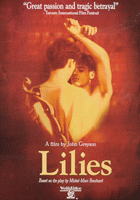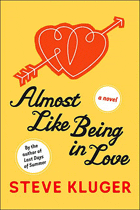 A
WolfeVideo DVD A
WolfeVideo DVDDirector: John Greyson Writer: Michel Marc Bouchard Some gay-themed films can be embarrassingly bad. The reluctance of mainstream studios to make them has resulted in too many poorly scripted, ill-plotted, woodenly acted, badly edited, unbelievably bewigged productions (you know the ones!). The most that can be said of them is that they are both brave and worthy. It comes as a revelation, therefore, to encounter so excellent a film as John Greyson’s Lilies, a tale of the revenge sought by a man incarcerated for forty years for a murder he didn’t commit. It is also a story of murder, betrayal, love, jealousy, hate, and madness. A film dealing with such powerful, Shakespearian themes needs to be exceptional if it is to do them justice. The screenwriter, Michel Marc Bouchard, on whose play, Les feluettes ou la repetition d’un drama romantique it is based, rises to the challenge magnificently. To say that this is a riveting story beautifully filmed is to do it scant justice. Watching it is an emotional experience that leaves one rapt and silent, rather as if one has just witnessed the performance of a lifetime in the concert hall, the opera house or on the sports field. This is because the actors are worthy of the task the writer has set them and do give the performance of a lifetime. The bones of the plot are these: it is 1912. Two teenage boys, Vallier de Tilly and Simon, are in love with each other. A boy called Bilodeau, a sanctimonious prig destined for the seminary, is jealous of their relationship but also in love with Simon. Simon’s father finds out about his relationship with Vallier via Vallier’s mother, who lives in her own fantasy world, and beats him. Simon then turns his back on Vallier to pay court to Lydie-Anne de Rozier who has just flown in (literally, in a balloon) from Paris. They get engaged but Vallier makes one last throw for Simon and wins. Unfortunately, all the while Bilodeau has been spying on them and is instrumental in Vallier’s death, for which he accuses Simon who is imprisoned. Forty years later, now Bishop Bilodeau, he is summoned to the prison, ostensibly to shrive the dying Simon but in reality to be forced to admit to his crimes. Simon is far from dying: he is blazingly alive, lacerated by forty years of raging injustice. He forces Bilodeau to watch a dramatic re-enactment by his fellow convicts of what happened forty years before. As will be by now apparent, this is a stylised and symbolic performance rather than a naturalistic one. Each scene begins in the prison chapel but soon opens out into the Quebec of 1912. All the parts, again a Shakespearian touch, are played by men. Every principal actor is superb and it would be invidious to single out any one above the others, but Danny Gilmore and Brent Carver must be mentioned. They give heart-breakingly beautiful performances as Vallier and his mother. The film is far more than the plot. The depth of emotion conveyed by the actors is enhanced and reinforced by the sets, the costumes and the sheer visual poetry of the filming and lighting. The ending is far from happy but is dramatically right. This film is not just an entertainment, it is an illuminating work of art. It deserves to become a classic. —Tony Heyes
|
 Almost Like Being in
Love Almost Like Being in
LoveBy Steve Kluger Published by Perennial 2004 ISBN: 0 –06–059583-3 Very often publishers categorise books on their fly leaves – “Ancient History”, “Biography” or whatever - so as to help the bookseller or librarian. That being so, it was something of a surprise to find Steve Kluger’s Almost Like Being in Love characterised as “Middle-aged men – Fiction”. At whom can this odd description, redolent as it is of thickening waistlines, thinning hair and thermal underwear, be aimed? It does the novel scant justice. First and foremost Almost Like Being in Love is a very amusing book; it is also a gay romance. Either of these descriptions would have been a more accurate summary of its theme. The book opens in 1978 as the story of two students at a boarding school. Travis Puckett is what we would now call a nerd and Craig McKenna is a jock (the word is used in the American sense of a sportsman and not in the English sense of a Scotsman). Travis has the ability to learn anything at great speed, has a mind like a computer, is compulsively neurotic and, in his own opinion, devoid of the gene that makes people “cool”. He is also selflessly kind, incensed by any kind of injustice and resigned to being the butt (the word is used in the English sense of target and not the American sense of backside) of homophobic jokes and violence. Craig, on the other hand, is typical of his own particular sub-species of high school boy – good looking, effortlessly popular and not given to burning the midnight oil over his studies. Inevitably, their paths cross. Travis falls (literally, from a stepladder) into Craig’s arms and they engage in their first conversation despite having had, but never having taken, the opportunity for four years. Craig asks him to help him out with an assignment, which he does, brilliantly, earning Craig his first ever A+ in English. In no time at all Craig discovers that Travis is like no one he has ever met. He becomes his protector and cannot understand why Travis thinks his uniqueness is a handicap; he falls in love with him. Travis reciprocates. There follows a torrid but brief relationship and they part to go to separate colleges, Travis on the West coast, Craig on the East. As it often the case in such circumstances, after a desultory correspondence their relationship lapses. Craig qualifies as a lawyer, acquiring a business partner, Charleen, and a controlling life partner, Clayton, who runs a successful hardware business. Travis becomes a history professor and has a series of short-lived relationships. No one ever matches up to Craig. He is haunted by the memory of what they had. Craig has lived happily, on and off, with Clayton for fourteen years but is chafing at the bit; he feels that Clayton is too ready to keep him under wraps and too anxious to rein in his crusading spirit. He learned his radicalism from Travis who was in this, as in all else, an excellent and inspiring teacher. After twenty years in the emotional wilderness Travis decides to seek Craig out to see what has become of him and to see what happens. Maybe there’s a chance Craig has not forgotten him. There follows a long period of sleuthing during which Travis gets himself into several scrapes, along the way winning the admiration of several people predisposed to regard him as a lunatic. When he finds that Craig is in a relationship honour holds him back. The resolution of his dilemma forms the epilogue of the book. Mr. Kluger has, it must be said, cleverly re-invented the eighteenth-century epistolary novel, expanding it beyond the confines of the letter to include journals, memoranda, faxes, telephone calls and emails. This device enables the reader to follow what is going on from a variety of viewpoints. The voices of all the protagonists are heard and the reader is granted omniscience. The story is recounted with great good humour and wit. At several points I found myself laughing aloud. My enjoyment would have been greater had the book’s major point of reference not been baseball. Too often parallels were drawn with long-dead players, long-gone matches and various match strategies. Many of the sporting allusions were quite baffling. This may be because of a cultural handicap from which I suffer, but the book would have had even wider appeal to those of us unfamiliar with the finer points, or even any of the points, of the game, without this obsessing over baseball diamonds. Nevertheless, it is a very enjoyable book and one to raise the spirits – well worth several reads. —Tony Heyes
|

